Jamie Yates
The art of football research can be a complex one. There is so much information out there. Enthusiasts around the world continue to contribute to the ever-growing mass of football writing and gathering of statistics every day. The internet has opened access to numerous historical resources, but also served to further the duplication of inaccurate information which has been perpetuated in print over the past near-150 years since the earliest days of ‘the Association game’. Newspaper records are a treasure trove, but mistakes were also made way back when, and, in many instances, inadvertently become fact, reappearing in football programmes, books, magazines and online publications forevermore.
I recently submitted an article to my Everton F.C. Heritage Society (EFCHS) colleague, and website coordinator Mike Royden, on a man named Pickering, who played for Everton in the 1880s. The men from those early days can be particularly tricky to trace with absolute certainty. There were no Opta stats back then, no Panini sticker albums, no weekly Shoot or Match magazine. Football history didn’t really exist at this point, it was literally being made from scratch in real time. Most of the players were working men, not celebrities as they are today. There were no encyclopedias or club statisticians. Players’ personal information wasn’t collated, and certainly not made available en masse to supporters, beyond the basics of team line-ups, match reports and the odd bit of gossip or trivia in the pages of the local press. The idea of collecting such information hadn’t really occurred to anybody yet. Fans were still inventing the art of fandom. Looking back now to trace the lives of those early heroes can often be a case of making an educated guess.
What do we know for sure? Contemporary newspaper reports tell us that a man named J. Pickering made numerous appearances for Everton Football Club between 1882-1887, before turning out a few times for our Anfield neighbours Oakfield Rovers.
Published in 2007, The Origins and Development of Association Football in the Liverpool District, c.1879 until c.1915, is a PhD thesis by Thomas J. Preston which includes at one point a short list of Everton players from the local area in 1881, their names, addresses and occupations. It includes a 24-year-old bricklayer living on Conway Street in Everton, by the name of Joseph Pickering. Another EFCHS colleague, Steve Johnson maintains the brilliant www.evertonresults.com website, an invaluable resource, and one which lists Joe Pickering as having made 73 appearances and scored 9 goals for Everton in the pre-Football League era.
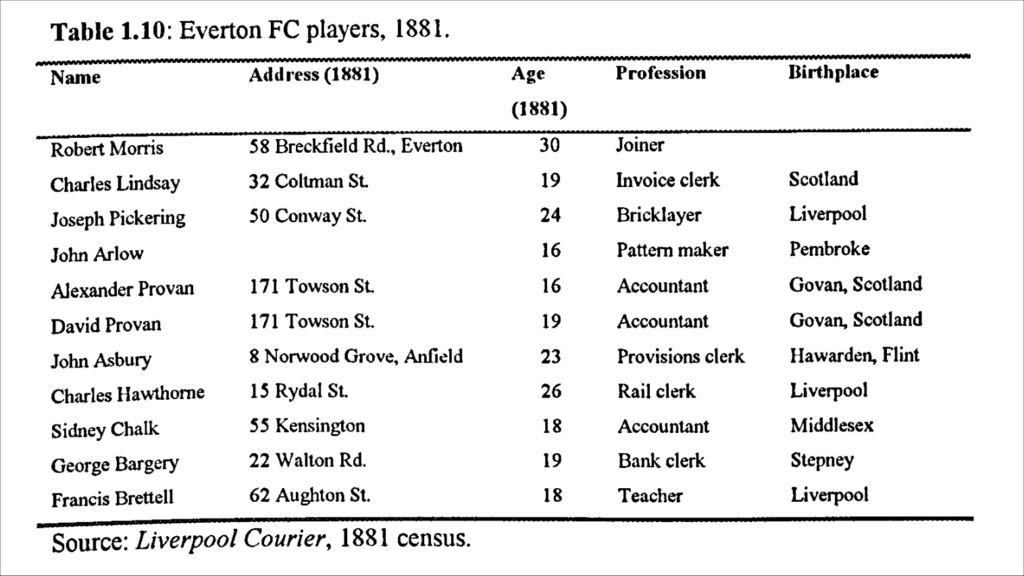
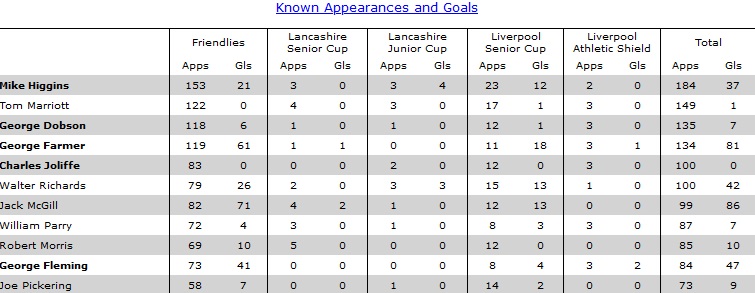
A team photograph from the era appears in Thomas Keates’ golden jubilee history book, with the team line-up appended. J. Pickering, middle row, far left. One newspaper team line-up from the period records W. Pickering playing in J. Pickering’s usual defensive position. After interrogating the census, birth, marriage and death records and local directories of Liverpool for the decade, a few candidates popped up, but the most consistent one was a bricklayer by the name of Joseph William Pickering, born in Liverpool in August 1856, who emigrated to the United States in 1887, within months of J. Pickering’s final appearance for Everton. Surely, this was our man.
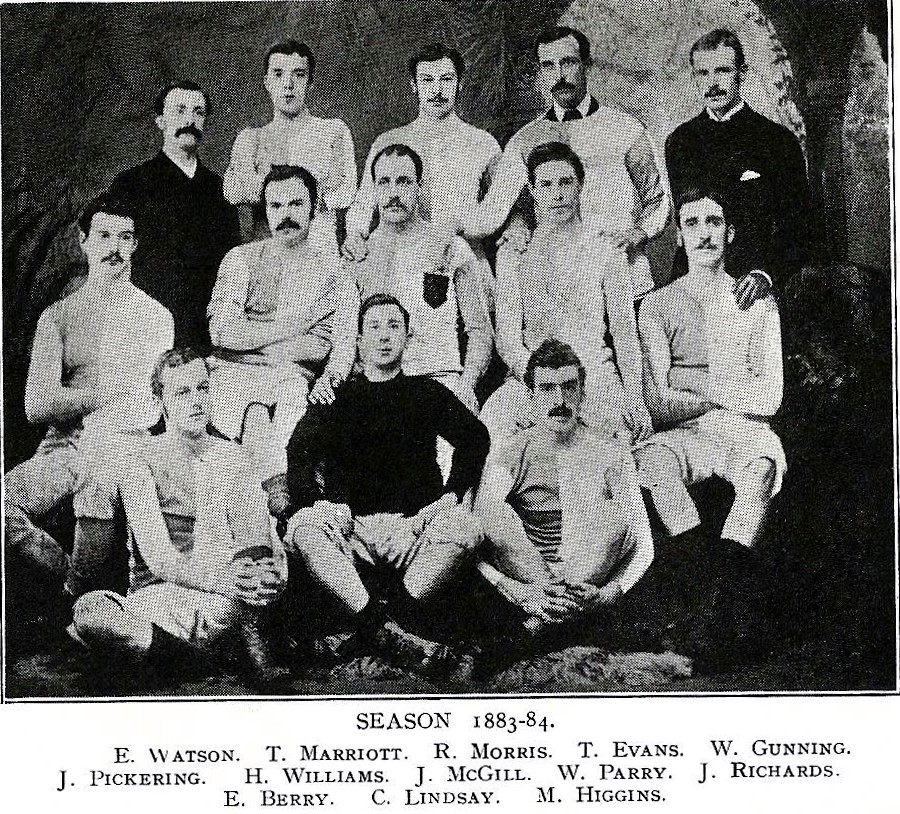
After the piece was published on the EFCHS website under the title ‘Joe Pickering: Everton Jersey to New Jersey’, I was searching google for some other nugget of Victorian era Evertonia when I stumbled upon another article on the EFCHS website, by another colleague of mine, the Everton historian Tony Onslow. I hadn’t seen the article before. Tony’s piece tells the story of three early Everton footballing stalwarts, Tom Marriott, Richard William Morris and JOHN Pickering:
‘The fourth child of Yorkshire-born parents Richard and Louisa, John Pickering first saw the light of day 21 October 1865, when the family lived on Netherfield Road in Everton. The 1881 census shows that they settled on Roxburgh Street in Walton and that John was serving an apprenticeship to become a plumber. He first played for the Everton 2nd XI before taking part in the game at Wrexham, where the visitors lost 5-3.’
Naturally, I panicked. I was sure I had the right man. The ‘W. Pickering’ listed in the newspapers could have been a typo, or even a mistyping of ‘J.W. Pickering’. Maybe? We all make mistakes, but have we ALL made a mistake?
Richard William Morris
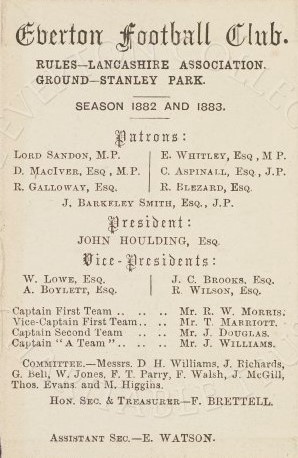
I also had my doubts about RICHARD William Morris, as I had also begun a piece on Morris myself, having found several references in Keates’ book and other newspaper cuttings about ROBERT, or Bob, Morris (usually recorded as R.W. Morris).
Tony Onslow again:
‘Born in 1862, Richard William Morris was the son of John, a sergeant major with the South Durham Militia, and his wife, Harriet. They were then living at Scar Cottage, Barnard Castle in County Durham. Richard was residing at this address and working as a gardener, when the census was taken 3 April 1881. On the 13th of the same month he was recorded as attending the Everton AGM at the Queen’s Head Tavern in Liverpool.’
Whereas my research has resulted in me starting work on a draft about the following individual:
‘Robert William Morris was one of the elder statesmen of early Everton line-ups. Born on 24 August 1850 at 28 Hornby Street in Vauxhall, the son of a Liverpudlian father, Robert William Morris (1828-1892), and Glaswegian mother, Euphemia Wilson (1829-1917), he followed in his father’s footsteps and trained as a joiner. Morris was already a married man and father of an infant son by the time the first football team was organised by members of St. Domingo’s Church, having wed Lancashire girl Ellen Bethell at St. Nicholas’ Church in Liverpool on 14 December 1876. The couple would go on to have five daughters and two sons.
After hanging up his boots, Robert Morris continued to work as a joiner and raise his large family alongside wife Ellen at their homes on Stockbridge Street and later Granton Road in Everton. His final appearance for Everton, aged 35 and alongside both Marriott and Pickering, came in a charity match on Saturday, 18 April 1885 at Haydock Temperence. Everton won 8-2 and the game is notable as the first in which George Farmer scored for Everton, the little left-winger from Oswestry bagging a hat-trick in what was only his second appearance for the club.
Having lived long enough to have at least been aware of, if not actually in attendance as one of the guests of honour at, the Golden Jubilee banquet of Everton Football Club which took place at the Adelphi Hotel in April 1929, Robert William Morris, one of the great early Everton stalwarts, died nine months later, aged 79, on 3 January 1930.’
I have located the gravestone at Anfield Cemetery of this Robert William Morris, but, without the holy grail of evidence, for instance from living descendants – believe me, I’m trying! – it is very difficult to prove that he is in fact the right man. Never mind whether Thomas J. Preston, Steve Johnson or Tony Onslow’s have the right Joseph, Joe or John Pickering – unless any of those three have any hard evidence – guys, in the name of Everton heritage, please share if so!
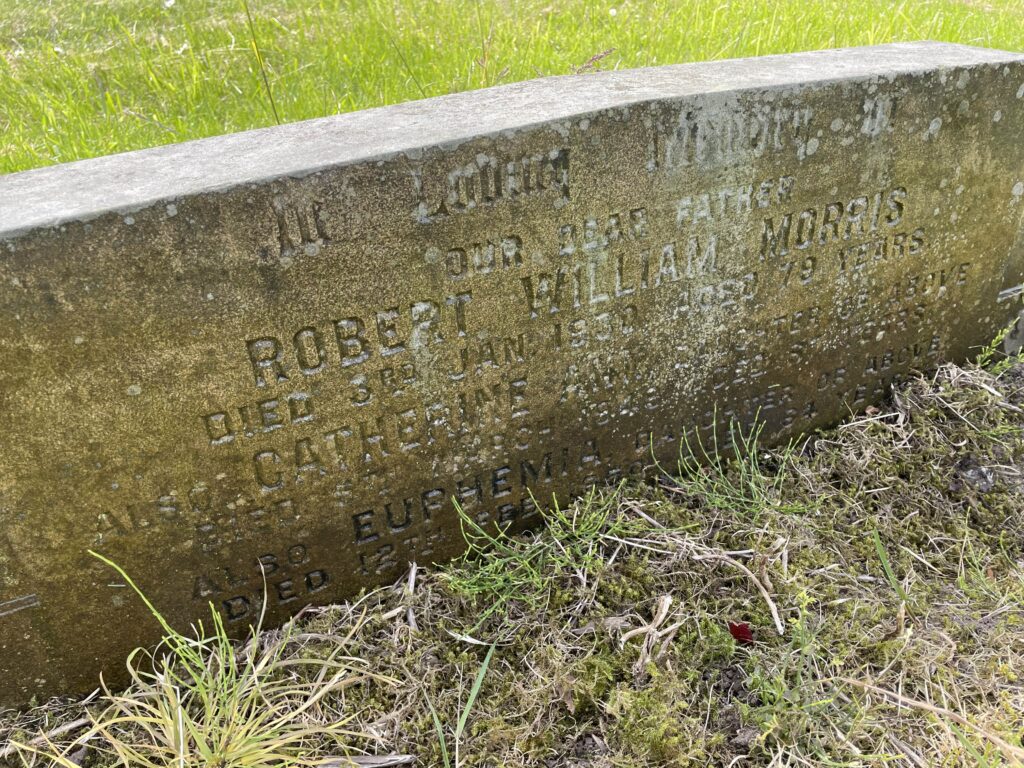
And then I found a photograph in the Liverpool Echo of 1 September 1928.
Late summer 1928 was a time of major nostalgia in Evertonian circles and the local press was awash with letters and tales of early Evertonia. The following was sent in by an early Everton player:
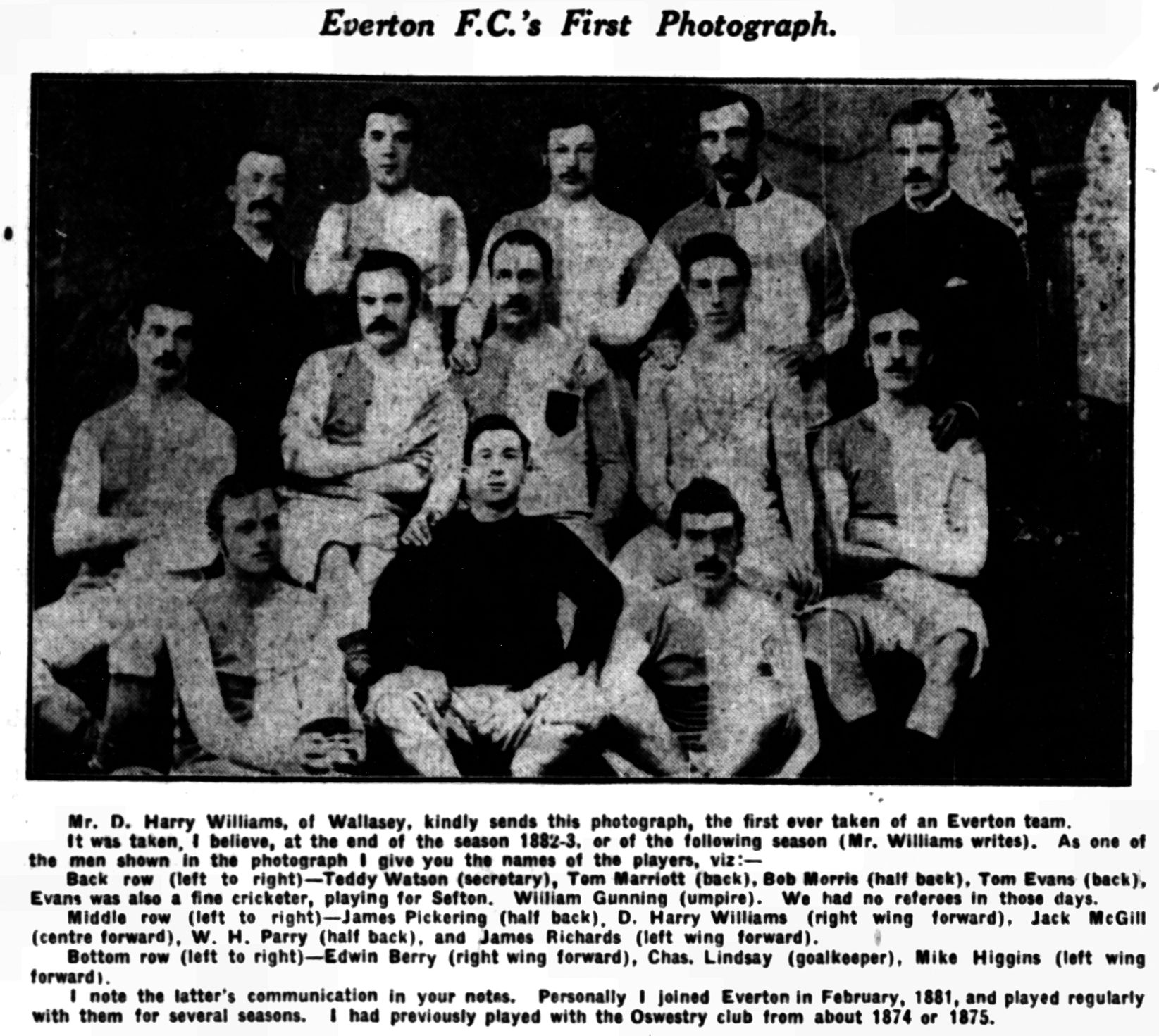
‘Mr. D. Harry Williams, of Wallasey, kindly sends this photograph, the first ever taken of an Everton team.
“It was taken, I believe, at the end of the season 1882-3, or of the following season (Mr. Williams writes). As one of the men shown in the photograph I give you the names of the players, viz: –
Back row (left to right) – Teddy Watson (secretary), Tom Marriott (back), Bob Morris (half back), Tom Evans (back), Evans was also a fine cricketer, playing for Sefton, William Gunning (umpire), we had no referees in those days.
Middle row (left to right) – James Pickering (half back), D. Harry Williams (right wing forward), Jack McGill (centre forward), W. H. Parry (half back), and James Richards (left wing forward).
Bottom row (left to right) – Edwin Berry (right wing forward), Chas. Lindsay (goalkeeper), Mike Higgins (left wing forward).
I note the communication in your notes. Personally, I joined Everton in February, 1881, and played regularly with them for several seasons. I had previously played with the Oswestry club from about 1874 or 1875.’
So, Bob Morris! That’s a bonus (if it’s accurate!).
And JAMES Pickering?
Surely a former teammate would have the correct Christian name. Wouldn’t they?
I’ve had a look around and the best candidate in this instance seems to be James Pickering, born in Liverpool in spring 1854, the son of an Irish couple, James, a bootmaker by trade, and Jane Pickering. The Pickering family were resident on Roscommon Street and later Northumberland Terrace in Everton throughout the 1870s into the 1880s. James married Mary Jane Curtis at St. Mary’s Church, at the top of County Road in Walton on Boxing Day 1881 and worked as a shipping clerk. The couple had two sons, Sydney and Harold. James died aged 80 in 1934 and was buried at Allerton Cemetery.
The fact is that, pending the discovery of conclusive evidence, we can’t be sure that he was the man who played for Everton.
I would add here that there is at least one Everton Football Club team photograph which was almost certainly taken prior to the one posted by Mr. D. H. Williams, who, according to www.evertonresults.com made at least 47 appearances, scoring 17 goals, for Everton between 1881/82-1884/85. So even D.H. Williams might not be spot-on about everything, and he played for Everton at the time!
Now all we need to do is figure out what the ‘D’ in D.H. Williams stands for!
………………………………………..
Reference
Thomas J. Preston’s PhD thesis is available online.
…………………………………………………
Links to two of the articles mentioned in the text can be found here
Tony Onslow, The Stanley Park Three (2015)
–
Jamie Yates, Joe Pickering: Everton Jersey to New Jersey (2024)

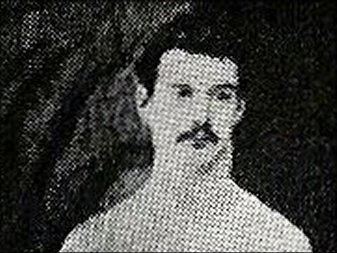

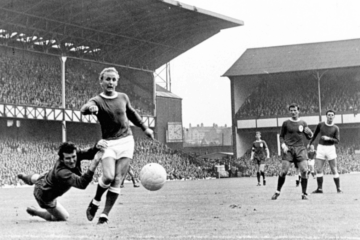

I am hoping you can help I have been trying to identify a photo of a football team for some years now the photo includes my late father Les Sumner the initials WA and the season 1946/7, I think the team could be Walton Amateurs who played in Division One of the Liverpool League back in the day if you think you can help I will of course send you a copy of the photo any help would be appreciated. I have been an Everton supporter since the late 1950’s and remember well the golden vision etc who won the league 1962/3. year
As always, a cracking EFCHS piece.
Just some fellow Blue advice, though, about the highly problematic Preston paper (alliteration unintended).
I would genuinely recommend that Evertonians avoid reference to it as much as possible. It’s a very damaging source and quite misleading in numerous ways.
I have long had my suspicions about why Preston took the positions that he did on various aspects of Everton history but that’s not for here.
I also think he was academically irresponsible for stating certain things quite categorically, without even a hint of caveat or nuance.
The danger of the Preston paper, for example, is that it was so easily and, in my view, gratuitously cited by John Williams in his “Red Men” biography of LFC a few years after, which went on to become a global bestseller and is seen as a definitive account of the Reds’ history. The truly irksome aspect of Williams’ citation of Preston – re. the dispute about whether St Domingo FC ever existed – is that he chose to reference the paper whilst at the same time admitting that it might have shortcomings, particularly given the fact that it was already known by the time that Red Men was published that Steve Flanagan had proved beyond a doubt that St Domingo did exist, exactly as we were all told.
Yet Williams still chose to muddy matters. That was disgraceful, especially from an academic of his standing. That genie isn’t going back in the bottle now, though, and it all stems from Predton.
It’s a shame in lots of respects that Preston’s paper is so flawed because it has a great deal going for it otherwise.
Basically, it’s astonishing that a man so obviously trained in academic research disciplines could have made the errors he did.
I genuinely don’t think, though, that he was oblivious to what he was alleging. I suspect an agenda. I’ll say it no stronger than that.
But Preston failed so many tests of historicity it’s barely believable. E.g.: EFC never played Everton UCC, for instance. Really? The records show otherwise. Also, there were apparently no reports of association football in the local Liverpool press in 1878/79, the “alleged” – his loaded term – year of St Domingo’s existence. Really? Just start at January 1879, and work from there, chronologically, and read in various titles about the formation of the Lancashire FA and essentially chart the printed pages’ gradual realisation that the Association “dribbling game” wasn’t a fad and the code was unstoppable in its popularity.
But more than all the above, all Preston ever had to do was read Alexander Nisbet’s famous interview given amidst the Everton blackballing in winter 1887 – that whole post-Bolton debacle – and take cue from his own words about the fact that St Domingo was indeed a linear part of the EFC story. What makes Nisbet’s words so valuable – given Preston and Williams – is that he was an arch Houlding-loyalist. Yet he clearly stated, just nine years after the formation of St Domingo that the club not only existed but was the precursor of EFC. Why would he, especially, have lied?
All in all, Preston is to be avoided, sad to say.
Best to all.
Thanks, Greg. You’ve picked up on the point of the article exactly as it was intended. I’d love to talk to you more about the EFC research rabbit hole and the many inconsistencies that are out there. Cheers!